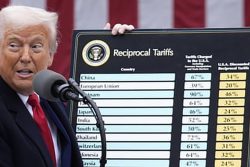Skeldon Energy Inc (SEI) officials said yesterday that safety and design issues at the sugar estate co-generation plant would require some US$17 million to be fixed in order for the facility to be operated efficiently.
Speaking at a press briefing after a tour of the plant located in the Skeldon Estate compound, Chairman of the SEI Board of Directors Lloyd Ross said there were “several design deficiencies; there was an issue with improper maintenance and an issue of training and operational oversight.” He added that several things were installed that have never really worked.

He revealed that the plant has not been able to provide energy to GuySuCo for the first crop this year, mainly because they had to embark on a major remedial and maintenance programme. “Repairs in the sense that it is remedial just to allow us to get to a level of safety that is acceptable for the operation of this plant, which did not exist prior to now,” he stated.
He added that the remedial and maintenance programme currently being carried out is expected to cost some US$2.5 million.
However, he further explained that the ultimate solution would be to purchase an adequate boiler to replace the two currently installed. This, along with other things was projected to cost some US$17 million. Clarifying, he added, “The US$17 million is not only to do with the replacement boiler, but it is also to do with the major repairs of the turbines, as well as adding a new 69 KB transformer.”

Ross stated that the work should be completed at the end of August, which would then allow the plant to provide energy to the sugar factory for the second crop, which is expected to begin in September.
According to Ross, the project is feasible. “The plant has not realized its full potential, simply because it has been inefficient in the use of the bagasse produced. It was only operating at a deficiency level, half of what was normally expected from a plant of this nature,” he stated.
He stressed that once they are able to rehabilitate the plant and return it to a level of safety and operability with the increase in efficiency, the result would be an economic benefit from the investment.
The state of the co-gen plant could complicate efforts by GuySuCo to privatize the Skeldon estate. Investors would see the Skeldon estate to be a more viable prospect if the co-gen plant was in tip-top shape.
Meanwhile, General Manager of SEI, Carl Duncan yesterday stated that the SEI management team along with workers and management of the co-generation plant had embarked on a “complete rehabilitation” of the plant. He stressed that the safety aspect of the boilers was very critical and needed immediate attention and work would also be done on the infrastructure itself. “We have been upgrading the infrastructure bit by bit, since then we have achieved a fair level of success and we will continue… all our plans are in place to have the boilers up and running by the end of August,” he said.
“We still have the reliability issues and the efficiency issues that we plan to address [after the completion of the second crop]. We have already programmed works to begin January next year and last another three to four months before we get ready for the second crop of 2018 again.”
‘Poorly designed’
Minister within the Ministry of Finance Jaipaul Sharma, who was on the tour along with members of the SEI board and representatives of GuySuCo told the media he planned to recommend to Cabinet that an investigation be launched into the co-generation plant. Sharma, who has direct responsibility for SEI, said he was told that the project was never officially certified. “So there is no certification document to say that we should have commenced operation at the facility,” he added.
Stating, “It was poorly designed,” he highlighted a fault with something as simple as the construction of a shed. Sharma explained that a shed was built for the boilers, but it was only big enough to cover one boiler. The consequent exposure to the elements, “caused the
exterior core of the boilers to deteriorate.” In addition, he said, there was an issue with the operation of the boilers. “The boilers were designed to use bagasse, but they used a large amount of heavy fuel oil (HFO),” Sharma added.
He explained that when he visited the facility he learnt that HFO was supposed to be used “only to jump start the boiler.” But “apparently the previous government forced GuySuCo to use HFO whenever there was a shortfall [of bagasse]. The oil accelerated the deterioration of the internal core of the boiler.”
He explained that the tubing of a boiler is usually 4 mm thick, but an inspection revealed that it was actually 1.5 mm. He then stressed that this could have caused an explosion, which would have seriously injured employees and would have had a major impact on the industry itself.
The Skeldon Co-generation Plant
The Skeldon Co-generation Plant comprises a 2×15 megawatts steam generation plant and a 10 megawatts HFO generating plant. It was commissioned back in 2009 as part of the Skeldon Sugar Modernisation Project, which was the first project in Guyana to be registered with the United Nations Framework Convention on Climate Change (UNFCCC).
That same year, then minister of agriculture Robert Persaud had announced that the project had qualified to receive incentives under the Kyoto Protocol’s Clean Development Mechanism.
The government was then quiet on the operations of the plant, but in 2014, then agriculture minister Dr Leslie Ramsammy had stated that the Skeldon Cogeneration Plant was supplying energy to the Guyana Power and Light Inc (GPL) grid.
A press release issued in April 2014 had quoted the minister as saying, “…The co-gen plant in Skeldon exported 5,644 MWH energy to the GPL national grid in March. Of this amount, 1,410 MWH or 25% was from the bagasse-based turbine generators. The rest, 4,233 MWH was from the diesel-based generators.”
He later told Stabroek News that the co-generation plant was operational full time and responsible for 20MW of energy per hour and as a result the amount of energy produced for the month of March would require over 490 hours.
Stabroek News had then contacted GPL to confirm how much energy was being supplied to it by the cogeneration plant but it was told that the information would not be available.
A year later, former head of the National Industrial and Commercial Investments Limited (NICIL) Winston Brassington announced that GuySuCo was selling the co-generation plant and three Wartsila power units at Skeldon SEI, a state-owned company specially created for the purpose, at a price of US$30 million.
According to a press statement issued, SEI was being funded with equity financing of US$5 million from NICIL, US$4 million from GPL and US$21 million in debt financing from GPL and local and international financial institutions. Brassington did not disclose from which institutions debt financing would be obtained. He had said, “in due course” the additional financiers will be revealed while noting that funding from GPL could be refinanced in the future.
Calling it a “win-win situation, he had stated that GuySuCo would be selling bagasse to the power company for the operation of the co-generation plant. It had been stated that it was expected that over 275,000 tonnes of bagasse would be produced at Skeldon in 2015. However, the Skeldon factory has had problems from the time it as set up and has never produced at full capacity.









